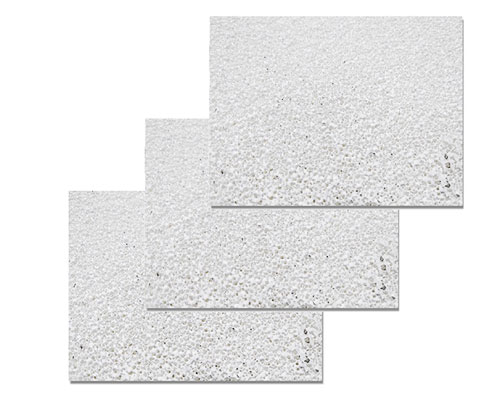Ceramic foam filter (CFF) is not only good in molten Alu filtration technology, but also easy to use. The initial pressure difference through the melt only needs to be 100~150mm, and once it passes, it only needs to maintain a pressure difference of 210mm. The principle of ceramic foam filtration is the same as that of ceramic tube filtration. They are both deep filtration mechanisms and have higher porosity (80%-90%) than ceramic tubes. Therefore, they have a large flow capacity and are suitable for filtration in continuous casting and continuous rolling production.
The ceramic foam filter molten Alu filtration technology is currently the most effective way to remove inclusions in the aluminum melt. In recent years, some new technologies for purifying molten aluminum have been researched at home and abroad, such as vacuum dynamic processing, ultrasonic continuous degassing purification, and corundum ceramic filters, which have received very good results. However, these process methods are more complicated and costly, and it is difficult to widely promote in the industry. The metal filter screen and fiber cloth filter used by low-end customers can only remove the large inclusions in the aluminum alloy melt, but the inclusions below the micron level cannot be removed, and the metal filter screen will also pollute the aluminum alloy.
The foam ceramic filters can filter out fine inclusions and significantly improve the mechanical properties and appearance quality of the product.
The main advantage of the ceramic filter system is that the slag generated during the transfer process outside the furnace is effectively eradicated through the filter, and the micron-sized inclusions in the aluminum liquid that the conventional process cannot do. At the same time, because the filter plate filters out fine inclusions, reduces the effective number of crystal nuclei in the aluminum liquid, so that the aluminum liquid nucleates and grows under larger supercooling conditions, shortens the solidification time, refine the structure, and reduces aluminum. The hydrogen content in the liquid. Hydrogen atoms can be adsorbed on some oxidized inclusions, and the oxidized inclusions can become the core of bubble growth, so the inclusions are filtered out and the gas on them is also removed. Through adsorption, the content of harmful elements (sodium, potassium) in the aluminum liquid can be removed. Therefore, according to different customer requirements, choosing a filter plate suitable for ensuring product quality can effectively control the removal of slag outside the slag furnace, mainly through ceramic filter plates.

